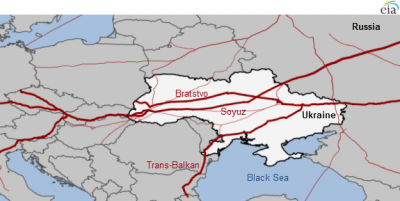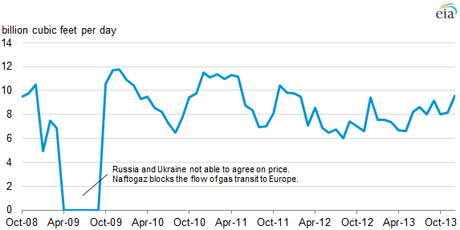 Major natural gas transit pipelines flowing through Ukraine. (Source: U.S. Energy
Major natural gas transit pipelines flowing through Ukraine. (Source: U.S. Energy Information Administration, IHS EDIN, and International Energy Agency)
Europe, including all EU members plus Turkey, Norway, Switzerland, and the non-EU Balkan states, consumed 18.7 trillion cubic feet (Tcf) of natural gas in 2013. Russia supplied 30% (5.7 Tcf) of this volume, with a significant amount flowing through Ukraine.
EIA estimates that 16% (3.0 Tcf) of the total natural gas consumed in Europe passed through Ukraine’s pipeline network, based on data reported by Gazprom and Eastern Bloc Energy.
Two major pipeline systems carry Russian gas through Ukraine to Western Europe—the Bratstvo (Brotherhood) and Soyuz (Union) pipelines. The Bratstvo pipeline is Russia’s largest pipeline to Europe. It crosses from Ukraine to Slovakia and splits in two to supply northern and southern European countries. The Soyuz pipeline links Russian pipelines to natural gas networks in Central Asia and supplies additional volumes to central and northern Europe. A third major pipeline through Ukraine (Trans-Balkan) delivers Russian natural gas to the Balkan countries and Turkey.
In the past, as much as 80% of Russian natural gas exports to Europe transited Ukraine. This number has fallen to 50%-60% since the Nord Stream pipeline, a direct link between Russia and Germany under the Baltic Sea, came online in 2011.

Russian natural gas exports to Europe through Ukraine, October 2008—December 2013. (Source: U.S. Energy Information Administration, International Energy Agency, and Eastern Bloc Energy)
Natural gas exports to Europe through Ukraine vary by season, ranging from almost 12 billion cubic feet (Bcf) of natural gas per day in the winter to only 6 Bcf per day in the summer. An unusually mild winter in 2013 meant reduced natural gas flows through Ukraine and contributed to higher levels of natural gas storage in Europe (natural gas storage levels were 46% full as of March 13, compared to 23% full in the United States).

